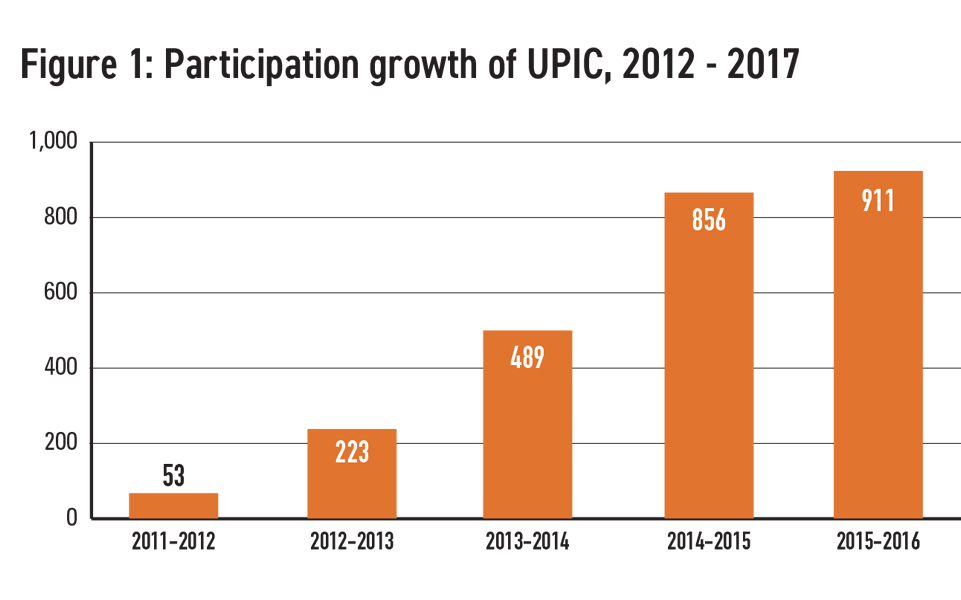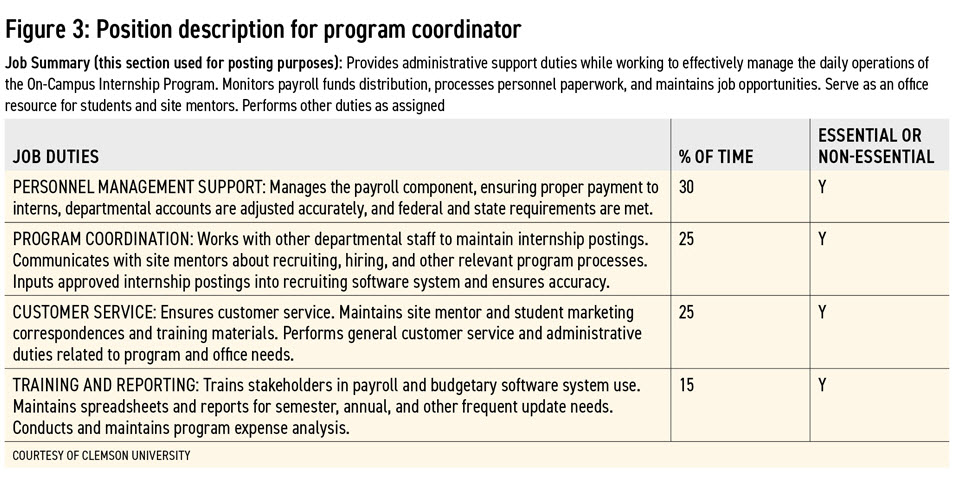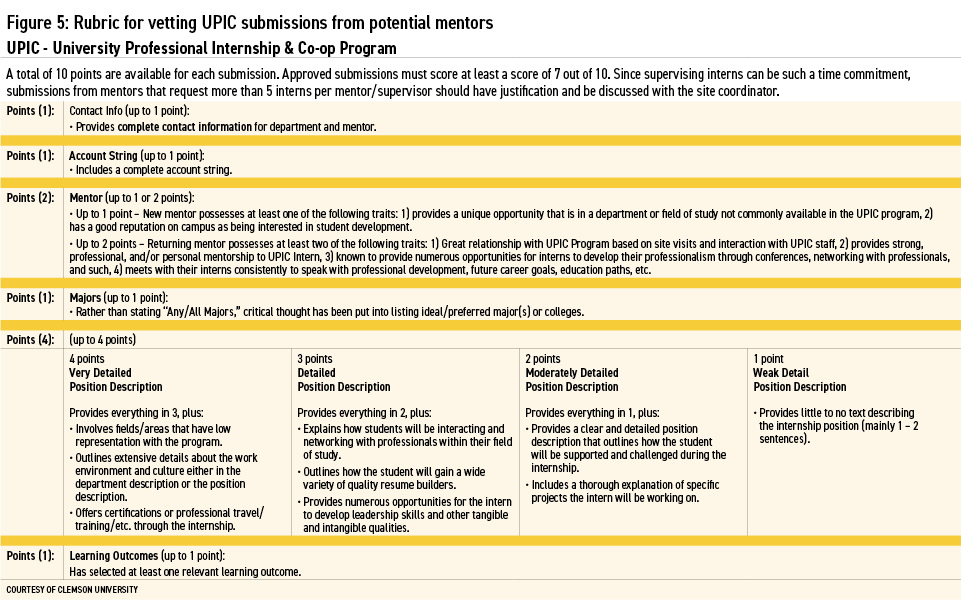NACE Journal, November 2018
See Also: Bringing On-Campus Internships to Your Campus: Challenges and Lessons Learned
Read MoreThrough its University Professional Internship and Co-op Program, Clemson University provides 1,000 students a year with the opportunity to gain experience, defray expenses, and build career readiness competencies.
Five engaged learning opportunities were developed to address the second priority—living-learning communities; creative inquiry; research; study abroad; and on-campus internships, which was aimed specifically at meeting the road map’s goal of providing every Clemson student with access to an engaged learning experience before graduation by the year 2020. To that end, Clemson launched its University Professional Internship and Co-op Program (UPIC) in 2012.
The program was designed to address a number of the “traditional” goals associated with experiential learning, e.g., encouraging career exploration, helping students gain professional experiences and build professional networks, and providing students with a means to defray educational expenses through compensation. But its on-campus nature also meant UPIC might have other effects, such as increasing persistence to graduation (as persistence is correlated to students having one-to-one relationships with faculty/staff), identifying talent that might be retained at Clemson following graduation, and providing more professional opportunities in a relatively rural setting.
Through the program, students are matched with on-campus positions, which are submitted by staff and faculty members for vetting and approval by UPIC staff. Staff and faculty members serve in the role of intern supervisor/mentor.
UPIC launched with a pilot group of 20 students during the spring semester of 2012. Since that time, the program has grown steadily: The 2012-2013 academic year increased to 223 student participants, the 2013-2014 academic year had 489 participants, and the 2014-2015 academic year almost doubled to more than850 participants. During the 2016-17 academic year, more than 900 students took part. (See Figure 1.) (Note: Due to funding restrictions, the program’s capacity is at the 900 to 1,000 student mark; however, interest far exceeds the number of available openings. Staff members working with the program continue to see a 15:1 student applications-to-position ratio.)

Anatomy of the UPIC Program
Program logistics and framework
Clemson University’s UPIC students fall into one of two experiential education categories. The largest portion of students participating in the program are considered part-time interns. These students typically maintain full course loads at the university and work at their on-campus internship sites 10 to 15 hours per week. As part of the program, all students are required to enroll in a zero-credit hour, pass/no pass, UPIC internship course. The curriculum associated with this course consists of orientations, site visits, final evaluations, and 160 contact hours. The payrate is set at $10 per hour for part-time internships, and students can receive a dollar pay increase, with each successful rotation in the program capping at $12 per hour. (See Figure 2.)
There is less participation in UPIC's full-time internship and co-op experiences. These pay $14 per hour, and rates increase by a dollar per hour for successful rotations, capping at $16 per hour. The UPIC course associated with the full-time experience maintains enrollment status so students typically do not take other coursework while interning. Full-time UPIC interns are required to work at least 320 contact hours.

Funding salaries
Every student participating in the program receives a set hourly rate preapproved by the university’s HR department. For the majority of these internship experiences, the UPIC program funds 50 percent of the intern’s salary and charges the hosting mentor’s department for the remaining 50 percent of the intern’s salary.
However, there are three additional salary sharing models sometimes leveraged by the UPIC staff:
- Mentors who have hired a student qualifying for federal work-study receive 75 percent of their salary costs covered from Financial Aid Office funds;
- Mentors who agree to take on an intern who is considered high risk or high needs, e.g., students on the spectrum, first-generation students, students referred from the Dean’s Office, pay no part of the salary—the UPIC program funds 100 percent of the salary; and
- Mentors’ departments pay 100 percent of the salary if all of the UPIC matching funds have been disseminated for the semester.
Staffing
At present, two program coordinators and three assistant or associate directors are employed to manage the operations of UPIC. In terms of organizational structure, these five staff members sit under the internship team framework within Clemson’s Center for Career and Professional Development.
The program coordinators are responsible for hiring interns, processing timesheets and payroll, and terminating students at the completion of a UPIC internship. (See Figure 3 for a position description.) The assistant and associate directors ensure that each student-intern receives at least one site visit per semester to address career development needs and to ensure the student-intern adheres to the academic requirements of the program. All team members participate in vetting mentor submissions, discussing the distribution of funds, and handling other general features of the program. (See Figure 4 for a sample timeline.)


Academic monitoring and program assessment
It should be noted that the UPIC program is not a student-worker, on-campus student employment, or federal work-study program.
Although these programs exist on campus, UPIC is housed within the internship programs of the Center for Career and Professional Development and is designed to be an on-campus, engaged learning, academic internship and co-op program. The program aligns with McClellan, Creager, and Savoca’s high-impact campus employment model that looks institution-wide to “engage key allies in the development and implementation process.”1 To that end, the UPIC staff members screen for high-quality, high-impact experiential education opportunities that can be tied back to either major-specific curriculum or professional career paths. For example, a finance major may intern in the office of the university’s chief financial officer, a psychology major may be engaged in admission counselor roles, a mechanical engineer may work with university facilities on building energy audits, a logistics or industrial engineering student could participate in parking services’ master planning activities, and a student majoring in English may work alongside the public relations staff.
The position descriptions that are submitted by mentors across campus are vetted by UPIC staff members, and any submission that does not secure a minimum score based on the vetting rubric criteria does not qualify as an UPIC internship. (See Figure 5.)
Further, mentors are evaluated through the site visit process and through the review of final evaluations completed by intern and mentor; any staff or faculty member who does not provide a worthwhile experience as a mentor is removed from the program.
Each student participating in the program is required to enroll in a corresponding, zero-credit hour internship course to ensure a tie back to academics. A large portion of the program outcomes and assessment indicators reported to administration, public relations, and other university offices are captured through the final evaluation process. Depending on the internship rotation for the student, discussions around career competencies, resume development, interview skills, and LinkedIn profiles are often covered during the site visit.

Budgets
The UPIC Office leverages four different funding sources to operate the program. First, the five UPIC staff members and one graduate student are employed primarily via funds from the Provost’s Office. Second, during the 2013-2014 academic year and in recognition of the program’s success, UPIC gained a recurring annual funding allocation of $1 million from the South Carolina Legislature to support intern salaries. These work force development monies account for the majority of the UPIC experiences. The federal work-study program along with revenues generated from the $200 UPIC zero-credit course are the third and fourth contributing sources to the budget. (Note: To date, the concept of leveraging private donors for additional resources has not been explored, and there are currently no plans to pursue this funding option.)
Program Outcomes
The UPIC staff works with the university’s Office of Institutional Research (OIR) as well as with other assessment units across campus to evaluate many of the program’s outcomes. Key among them: Students who participated in UPIC are 20 percent more likely than their peers to have a job offer upon graduation, according to Clemson’s first-destination survey.2
Similarly, final evaluations administered to UPIC students at the end of their internship experience reveal that more than 90 percent of the students participating in UPIC provided a rating of “good” or “excellent” when asked about their a) relationship with their mentor, b) communication patterns with their mentor, c) practical skills gained through the internship, and d) engagement with non-supervising faculty and staff at their internship. (Note: Although Clemson’s OIR staff is not ready to release findings related to UPIC and persistence, UPIC students’ evaluation results bode well. According to Astin’s longitudinal work on persistence-to-graduation, having a meaningful connection and engaging interaction with a faculty or staff member on a college campus is one of the biggest contributors for keeping students from transferring or dropping out of college.3)
Also in terms of results, albeit not one tracked through OIR, one of the objectives of the program has been to help offset the cost of attending colleges. Over its first four years, UPIC provided more than $3 million in student salaries; since then, the program has averaged approximately $2 million per year in salaries for students.
Career Readiness Competency Results
The National Association of Colleges and Employers unveiled its career readiness competencies in late 2015.4 At about the same time, Clemson University implemented its own career competencies. These nine competencies—communication, collaboration, leadership, self-awareness, integrity and ethics, brand, adaptability, analytical skills, and technology—are being integrated into curricular and extracurricular work on Clemson’s campus, and the UPIC program is no exception.
The UPIC staff are making efforts to close this competency gap by making the career competency discussion a part of every aspect of the UPIC experience, including the submission and vetting process, site visit interviews, intern and mentor training and orientation sessions, and final evaluations. UPIC interns become familiar with the competencies early on through internship program orientations, and the competencies are reinforced through site visits conducted by the UPIC staff and homework assignments associated with the UPIC internship course.
As a result of incorporating career competency language into the various aspects of the UPIC program, measurable career competency outcomes are identified on the students’ final evaluations, which are completed by students and supervisors (or mentors) at the end of the semester. For example, after participating in an internship, all UPIC interns are able to rank their proficiency level for each of the nine career competencies on a Likert scale (1 to 5) and provide a short story that addresses their proficiency level while answering a competency-based interview question; this storytelling exercise helps prepare students for full-time interviews. Similarly, 100 percent of UPIC interns are able to explain the significance of their experience in relation to their future career aspirations. They do this by listing specific companies of potential interest to them on their final evaluation.
Other Models
Clemson University’s on-campus internship program is only one model that is being employed to engage students in on-campus internships.
A number of other institutions offer their own spin on such a program. Coastal Carolina University (On-Campus Internship Program), University of Central Oklahoma (Intern UCO Program), University of North Carolina-Charlotte (University Professional Internship Program), Brigham Young University Marriott School of Business (On-Campus Internship Program), Davidson College (Summer Internship Grants Program), and Boston University (Yawkey Nonprofit Internship Program) are just a few higher education programs that have their own approach to the on-campus internship.
An increasing number of these on-campus internship models are being implemented on campuses across the nation every day. The benefits and outcomes associated with these programs are sizable, but so too is the cost associated with operating them. A quality program worth investing in will be expensive, so it is important to investigate, benchmark, and develop a framework based on your university’s unique challenges, assets, and priorities.
Endnotes
1McClellan, G., Creager, K., & Savoca, M. (2017). A good job: Campus employment as a high-impact practice. Sterling, VA: Stylis Publishing, p. 198.
2Center for Career and Professional Development (2017). Clemson University’s 2016-2017 first destination survey. Retrieved from: http://media.clemson.edu/studentaffairs/fb/ccpd-annual-report-16-17/index.html
3Astin, A. W. (1993). What matters in college? Four critical years revisited. San Francisco, CA: Jossey-Bass Publishers.
4National Association of Colleges and Employers. (2016). Career readiness defined. Retrieved from www.naceweb.org/career-readiness/competencies/career-readiness-defined/
References
Association of Public and Land-grant Universities (2015). Innovation and economic prosperity award case study: A national model for building student talent in higher education. Retrieved from: http://www.aplu.org/projects-and-initiatives/economic-development-and-community-engagement/innovation-and-economic-prosperity-universities-designation-and-awards-program/IEP_Library/clemson-university-ccpd/file
Astin, A. W. (1985). Achieving educational excellence: A critical assessment of priorities and practices in higher education. San Francisco: Jossey-Bass.
Astin, A. W. (1996). Involvement in learning revisited: Lessons we have learned. Journal of College Student Development, 37. 123-134.
Boston College (2018). Yawkey nonprofit internship program. Retrieved from: http://www.bu.edu/careers/internships-and-jobs/bu-internship-programs/yawkey/
Brigham Young University (2018). Marriott school of business on campus internships. Retrieved from: https://marriottschool.byu.edu/oci
Clemson University (2011). 2020 Roadmap. Retrieved from: http://www.clemson.edu/2020/documents/road-map-publication.pdf
Coastal Carolina University (2018). On-campus internship (OCI) program. Retrieved from: https://www.coastal.edu/internships/on-campusinternships/
Cooperative Education and Internship Association. (2015). History of cooperative education and internships. Retrieved from http://www.ceiainc.org/history
Davidson College (2017). Summer internship grants. Retrieved from: https://www.davidson.edu/offices/career-development/students/acquiring-an-internship/internship-compensation-and-credit/summer-internship-grants
Field, K. (2017). Making students’ jobs more meaningful. Chronicle of Higher Education. Retrieved from: https://www-chronicle-com.libproxy.clemson.edu/article/Making-Students-Jobs-More/241576
Healthcare.gov. (2018). Affordable care act. Retrieved from: https://www.healthcare.gov/glossary/affordable-care-act/
Kelley-Hall, C. On-campus internships: maximizing opportunities for student engagement. White paper (2011).
Klaus, H. & Hill, A. (2018). UPICMagazine: Issue 6. Clemson, SC: SAPUBS.
Nunamaker, T., Walker, K., & Burton, O. (2017). Competencies: The not-so-uncharted frontier and a call to learn from employers. NACE Journal, LXXVIII(2), 29-35.
Sandoval, T. (2012). Clemson meets student demand with big investment in campus internships. Chronicle of Higher Education. Retrieved from: https://www.chronicle.com/article/Clemson-Meets-Student-Demand/132343
University of North Carolina-Charlotte (2018). University professional internship program. Retrieved from: https://career.uncc.edu/resources/experience/university-professional-internship-program-upip






